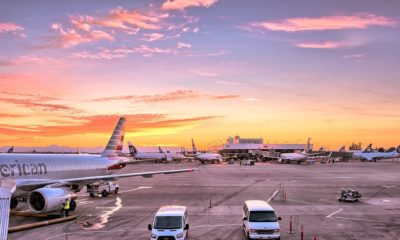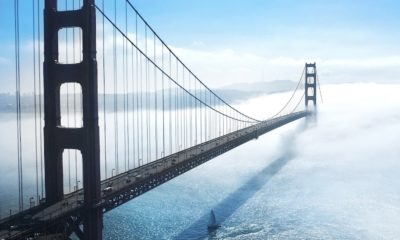Business
Local officials addressing infrastructure needs as federal plan stalls
Both parties in Congress are trying to negotiate a compromise bill deal on a joint infrastructure plan, but time is definitely running short. The proposed American Jobs Plan (Infrastructure Bill) allocates an additional $100 billion over eight years for high-speed broadband infrastructure projects. President Biden has proclaimed that he plans to pass a bill with or without bipartisan support.

Earlier this month, the country celebrated another annual Infrastructure Week. For the last nine years, leaders have convened from across America to highlight the critical role infrastructure plays in the economy, job creation, public health, and national security. But, for many years the celebrations have been rather mild since there has been little to celebrate.
However, that might change soon. In March, President Biden released a summary of his American Jobs Plan, also referred to as the newest Infrastructure Plan. The proposed $2.25 trillion plan would allocate $621 billion to infrastructure projects of various types. The funding would be targeted for the repair and construction of roads, bridges, public transit, and rail service. It also would provide revenue for projects related to broadband expansion, water resources, airports, ports, health care, technology modernization, and more.
In April, Senate Republicans announced a completely different infrastructure plan. The proposed $568 billion GOP package would allocate:
- $299 billion for roads and bridges.
- $65 billion for broadband.
- $61 billion for public transit.
- $44 billion for airports.
- $35 billion for drinking water and wastewater systems.
- $20 billion for railways.
- $17 billion for ports and inland waterways.
- $14 billion for water storage.
- $13 billion for safety measures.
Both parties in Congress are trying to negotiate a compromise bill deal on a joint infrastructure plan, but time is definitely running short. Although hope remains for a bipartisan bill, a large delta separates what the Democrats want to spend and what the Republicans are willing to spend. Senate Minority Leader Mitch McConnell says the GOP could support a plan of up to $800 billion … but no more. President Biden has proclaimed that he plans to pass a bill with or without bipartisan support.
Time, however, is running out and as the world waits for Congress to act, many upcoming projects appear to be an indication of what can be expected in the months to come – whether the highly anticipated infrastructure bill becomes law this year or not.
Washington State
State legislators in Washington approved a $6.3 billion capital construction budget for 2021-23 that allocates $411 million for local broadband infrastructure projects. The funding covers:
- A $326 million funding allocation for the Washington State Broadband Office grants program – all earmarked for broadband projects.
- $60 million for Public Works Board grants and loans to bring broadband to unserved areas.
- A $25 million funding allocation to the Community Economic Revitalization Board for grants and loans to expand broadband in underserved and rural communities.
The proposed American Jobs Plan (Infrastructure Bill) allocates an additional $100 billion over eight years for high-speed broadband infrastructure projects.
Iowa
The governor of Iowa recently signed a new law that provides funding to install broadband in high-need areas in Iowa. Lawmakers agreed to spend $100 million on broadband projects in the new fiscal year which begins July 1. Iowa currently has the second slowest broadband speeds in the nation.
Ohio
More than 1,370 bridges in Ohio are classified as “structurally deficient,” according to the most recent inspections from 2020. Most of the bridges of concern are in rural areas but many are in urban areas with much higher numbers of motorists traveling over them daily.
The American Road and Transportation Builders Association estimates the combined cost of repairing Ohio’s bridge infrastructure is $2.4 billion. President Biden’s infrastructure plan calls for a $115 billion increase in spending toward U.S. bridges most in need of repairs. This includes fixing the “ten most economically significant bridges in the country,” as well as 10,000 smaller bridges.
Oklahoma
Tulsa County needs about $30 million in funding to replace structurally deficient or obsolete bridges and another $10 million in other essential bridge repairs. The county also has about $30 million in unfunded or under-funded road and levee projects. The Oklahoma Department of Transportation oversees 6,800 bridges, and 86 are structurally deficient but progress is occurring. The Improve Our Tulsa-2 funding package dedicated $8.9 million to the city, and 40 bridges have been selected for upgrades.
Louisiana
The Interstate 10 Calcasieu River bridge in Lake Charles is 70 years old, and its intended lifespan was only 50 years. A replacement bridge will cost about $850 million, and the state agreed to funding of $114 million. The Urban Area Metropolitan Planning Organization’s Transportation Policy Committee is reviewing proposed alternatives to replace the aging bridge. A task force is recommending that bicycle/pedestrian infrastructure be part of the new bridge to connect both sides of the Calcasieu River.
Indiana
Transportation officials in Indiana are considering bridge upgrades and road projects in the event that President Biden’s infrastructure plan become law. The state has 1,111 bridges in poor condition. Another 5,478 miles of highway is in poor condition. Each driver in the state pays $638 a year in costs that result from driving on roads in dire need of repair.
There also are emergency needs. A semi tractor-trailer struck the 217th Street Bridge over Interstate 65 in 2019 and the bridge has been closed since then. In fiscal year 2021 the Indiana Department of Transportation approved almost 100 bridge projects, but funding has not been available for all high priority projects.
Illinois
Work is underway on a five-year Chicago Works plan to repair the city’s crumbling streets, sidewalks, bridges, and shoreline. City officials also plan to spend $600 million in 2021 on infrastructure modernization projects.
The City Council voted to borrow $1.4 billion to fund the first two years of the plan that allocates $3.7 billion to repair the city’s aging infrastructure. This plan will repair and replace roads, bridges, sidewalks, crosswalk ramps, streetlights, and traffic signals and fund nine neighborhood projects. Within the next two years, Chicago’s Department of Transportation will resurface 75 miles of streets a year and repave 1,240 residential blocks.
Infrastructure projects of all types are in the future for the next decade, regardless of Congressional action.
—
(Featured image by 12019 via Pixabay)
DISCLAIMER: This article was written by a third party contributor and does not reflect the opinion of Born2Invest, its management, staff or its associates. Please review our disclaimer for more information.
This article may include forward-looking statements. These forward-looking statements generally are identified by the words “believe,” “project,” “estimate,” “become,” “plan,” “will,” and similar expressions. These forward-looking statements involve known and unknown risks as well as uncertainties, including those discussed in the following cautionary statements and elsewhere in this article and on this site. Although the Company may believe that its expectations are based on reasonable assumptions, the actual results that the Company may achieve may differ materially from any forward-looking statements, which reflect the opinions of the management of the Company only as of the date hereof. Additionally, please make sure to read these important disclosures.

-

 Crowdfunding1 week ago
Crowdfunding1 week agoFrom Confiscation to Cooperation: Funding Casa de la PAZ’s Social Transformation
-

 Business5 days ago
Business5 days agoWhy the iGaming Industry Offers Some of the Best ROI for Affiliate Marketers
-

 Crowdfunding2 weeks ago
Crowdfunding2 weeks agoDolci Palmisano Issues Its First Minibond of the F&P “Rolling Short term” Program
-

 Africa2 days ago
Africa2 days agoBLS Secures 500 Million Dirhams to Drive Morocco’s Next-Gen Logistics Expansion
























